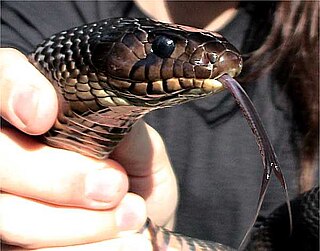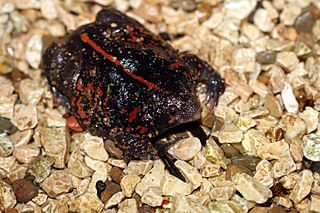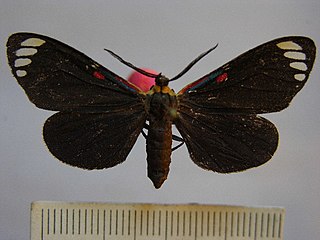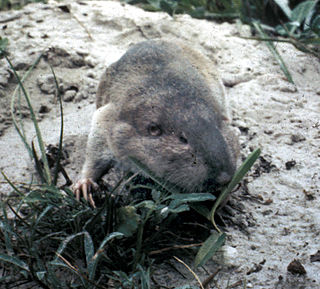 W
WThe North American green toad, Anaxyrus debilis, also known by its old name Bufo debilis, is a species of toad found in the southwestern United States in the states of Arizona, New Mexico, Colorado, Kansas, and Texas, as well as in northern Mexico in the states of Tamaulipas, San Luis Potosí, Durango, and Zacatecas. It is commonly called green toad.
 W
WAztlanolagus is an extinct monotypic genus of rabbit that lived during the Quaternary in what is now the Southern to Southwestern United States and northern Mexico. Aztlanolagus agilis is currently the only recognized species, though differences among recovered fossils suggest that there may have been other species. The generic name refers to Aztlán, the legendary place of origin of the Nahua peoples as recorded in the mythological accounts of the Aztecs and other Nahua groups. By some traditions, this legendary locale is placed in the border regions of the Southwestern United States and adjacent northern Mexico.
 W
WThe southern yellow bat is a species of vesper bat that belongs to suborder microchiroptera (microbat) in the family Vespertilionidae. It is native to South, North and Central America, from the Rio Grande Valley of Texas in the United States to Argentina.
 W
WThe Big Bend slider, also called the Mexican Plateau slider, is a species of aquatic turtle in the family Emydidae. The species is endemic to the Southwestern United States and northern Mexico.
 W
WThe cane toad, also known as the giant neotropical toad or marine toad, is a large, terrestrial true toad native to South and mainland Central America, but which has been introduced to various islands throughout Oceania and the Caribbean, as well as Northern Australia. It is a member of the genus Rhinella, which includes many true toad species found throughout Central and South America, but it was formerly assigned to the genus Bufo.
 W
WThe Texas cichlid is a freshwater fish of the cichlid family. This is the only cichlid species that is native to the United States. The fish, also known as Rio Grande cichlid, originates from the lower Rio Grande drainage in Texas near Brownsville and Northeastern Mexico.
 W
WThe Texas cichlid is a freshwater fish of the cichlid family. This is the only cichlid species that is native to the United States. The fish, also known as Rio Grande cichlid, originates from the lower Rio Grande drainage in Texas near Brownsville and Northeastern Mexico.
 W
WThe common Mexican tree frog is a nocturnal species of tree frog whose native range extends from the Sonoran Desert and the Lower Rio Grande Valley of Texas south to Costa Rica. Common names include Mexican tree frog, Baudin's tree frog and Van Vliet's frog. They are usually found within lightly forested areas near permanent sources of water.
 W
WThe Rio Grande cooter is a species of turtle in the family Emydidae. The species is native to northeastern Mexico and the adjacent southwestern United States.
 W
WCrotaphytus reticulatus, commonly called the reticulate collared lizard, is a species of moderately sized lizard in the family Crotaphytidae. The species is native to semiarid, rocky regions of the Tamaulipan mezquital. Its range includes the US state of Texas and the Mexican states of Coahuila, Nuevo León, and Tamaulipas. Of all the species in the family Crotaphytidae, C. reticulatus is the only species which is not restricted to rocky habitats.
 W
WThe Rio Grande cutthroat trout, a member of the family Salmonidae, is found in northern New Mexico and southern Colorado in tributaries of the Rio Grande.,
 W
WThe desert pocket gopher is a species of rodent in the family Geomyidae. It is found in the state of Chihuahua in Mexico and in Texas and New Mexico in the United States.
 W
WDrymarchon melanurus erebennus, commonly known as the Texas Indigo Snake, is a subspecies of large, nonvenomous snake in the family Colubridae. The subspecies is native to Texas and adjacent Mexico.
 W
WDrymobius margaritiferus, commonly known as the speckled racer, is a species of nonvenomous colubrid snake native to the Americas. The specific name, margaritiferus, means "pearl-bearing" in Latin, referring to the pearl-like spots on the dorsal scales.
 W
WEleutherodactylus cystignathoides, also known as the Rio Grande chirping frog, Mexican chirping frog, or lowland chirping frog, is a small eleutherodactylid frog. It is found from the southern United States in Texas, and in the northeastern Mexico in the states of Nuevo León, Tamaulipas, San Luis Potosí, Hidalgo, and Veracruz. Its range in Texas has expanded because of transport in potted plants, and there is also a likely introduced population in Louisiana.
 W
WThe spotted chirping frog or Mexican cliff frog, Eleutherodactylus guttilatus, is a species of small Eleutherodactylid frog native to the southern United States and Mexico. They are found in moderate elevation ranges of the Sierra Madre Oriental mountain range, from the Davis Mountains in west Texas south to the Mexican states of Coahuila, Nuevo León, San Luis Potosí, Durango and Guanajuato. They grow from 0.75 to 1.25 inches in length, and are easily mistaken for other Eleutherodactylus species, with which they share range. This has led to some confusion in its taxonomic classification.
 W
WEupackardia is a monotypic moth genus in the family Saturniidae erected by Theodore Dru Alison Cockerell in 1912. Its only species, Eupackardia calleta, the calleta silkmoth, was described by John O. Westwood in 1853. It is found in Mexico, Guatemala, as well as in the states such as; Arizona, New Mexico, and Texas.
 W
WFicimia streckeri, also commonly known as the Mexican hooknose snake, the Tamaulipan hooknose snake, and the Texas hook-nosed snake, is a small species of snake in the family Colubridae. The species is native to northeastern Mexico and adjacent southern Texas.
 W
WEleutherodactylus cystignathoides, also known as the Rio Grande chirping frog, Mexican chirping frog, or lowland chirping frog, is a small eleutherodactylid frog. It is found from the southern United States in Texas, and in the northeastern Mexico in the states of Nuevo León, Tamaulipas, San Luis Potosí, Hidalgo, and Veracruz. Its range in Texas has expanded because of transport in potted plants, and there is also a likely introduced population in Louisiana.
 W
WThe Rio Grande leopard frog is a species of aquatic frog native to the southern United States in Texas and New Mexico, and south through Mexico and Central America. It is also sometimes referred to as the Mexican leopard frog. The epithet berlandieri is in honor of the naturalist Jean Louis Berlandier, who worked for the Mexican government on one of the first biological surveys of Texas.
 W
WHolbrookia propinqua is a species of phrynosomatid lizard.
 W
WIctalurus lupus is a species of catfish in the family Ictaluridae. It resembles the closely related channel catfish, but is smaller, lacks spots, and has a caudal fin with a shallower fork, and grows to a total length of 48 cm (19 in). It is found in Northeastern Mexico and the Southwestern United States.
 W
WThe green kingfisher is a resident breeding bird which occurs from southern Texas in the United States south through Central and South America to central Argentina.
 W
WLasaia sula, the blue metalmark, is a species of butterfly in the family Riodinidae that is native to North America. It ranges from the Lower Rio Grande Valley of Texas in the United States south to Honduras and inhabits subtropical forests, forest edges, and agricultural areas.
 W
WLeptodactylus fragilis, known under many common names such as the Mexican white-lipped frog, American white-lipped frog or simply white-lipped frog, is a species of leptodactylid frog. Its distribution ranges from the Lower Rio Grande Valley of Texas in the United States south through Mexico and Central America to Colombia and Venezuela. It is often—wrongly—referred to as Leptodactylus labialis (Cope, 1878), which is a junior synonym of Leptodactylus mystacinus.
 W
WThe Mexican burrowing toad is the only species in the genus Rhinophrynus and the family Rhinophrynidae of order Anura. Their distribution stretches from south Texas through Mexico, Belize, Guatemala, Honduras, and El Salvador to Nicaragua and Costa Rica. R. dorsalis mostly commonly inhabits the subtropical and tropical dry forests within its range characterized by wet and dry seasons, but may also be found during periods of heavy rain in pastures, cultivated field, roadside ditches or other open areas. The family was once more widespread, including species ranging as far north as Canada, but these died out in the Oligocene.
 W
WThe Devils River minnow is a species of ray-finned fish in the family Cyprinidae. The minnow coexists with other closely related species and other cyprinids in the range of northern Mexico and southern Texas.
 W
WOryzomys couesi, also known as Coues's rice rat, is a semiaquatic rodent in the family Cricetidae occurring from southernmost Texas through Mexico and Central America into northwestern Colombia. It is usually found in wet habitats, such as marshes, but also lives in drier forests and shrublands. Weighing about 43 to 82 g, O. couesi is a medium-sized to large rat. The coarse fur is buff to reddish above and white to buff below. The hindfeet show some specializations for life in the water, such as reduced ungual tufts of hair around the digits. It has 56 chromosomes. There is much geographic variation in size, proportions, color, and skull features. Oryzomys couesi is active during the night and builds nests of vegetation that are suspended among reeds about 1 m (3.3 ft) above the ground. It is an excellent swimmer and dives well, but can also climb in vegetation. An omnivore, it eats both plant and animal food, including seeds and insects. It breeds throughout the year; females give birth to about four young after a pregnancy of 21 to 28 days. The species may be infected by several different parasites and by two hantaviruses.
 W
WParevander xanthomelas is a species of beetle in the family Cerambycidae. It was described by Félix Édouard Guérin-Méneville in 1844, and has been classified in the genus Parevander since the circumscription of that genus by Per Olof Christopher Aurivillius in 1912.
 W
WPhaloesia is a monotypic of tiger moth genus in the family Erebidae. Its only species is Phaloesia saucia, the saucy beauty moth. The genus and species were first described by Francis Walker in 1854. It is found from the lower Rio Grande Valley of Texas in the United States to Venezuela.
 W
WPhocides polybius, the bloody spot or guava skipper, is a species of butterfly in the skipper family, Hesperiidae, that is native to the Americas. It is found from the lower Rio Grande Valley of southern Texas in the United States south through Mexico and Central America to Argentina. The species was first described by Johan Christian Fabricius in 1793.
 W
WThe Rio Grande silvery minnow or Rio Grande minnow is a small herbivorous North American fish. It is one of the seven North American members of the genus Hybognathus, in the cyprinid family.
 W
WSceloporus grammicus is a species of lizard from Mexico and the southern United States. It is sometimes referred to as the mesquite lizard or graphic spiny lizard.
 W
WThe Chihuahua shiner is a species of freshwater ray-finned fish from the family Cyprinidae, the carps and minnows. It is found in southern Texas and northern Mexico.
 W
WSiproeta stelenes (malachite) is a Neotropical brush-footed butterfly. The malachite has large wings that are black and brilliant green or yellow-green on the upperside and light brown and olive green on the underside. It is named for the mineral malachite, which is similar in color to the bright green on the butterfly's wings. Typically, the wingspread is between 8.5 and 10 cm. The malachite is found throughout Central and northern South America, where it is one of the most common butterfly species. Its distribution extends as far north as southern Texas and the tip of Florida, to Cuba as subspecies S. s. insularis, and S. s. biplagiata, and south to Brazil.
 W
WSistrurus catenatus edwardsii is a subspecies of venomous pit viper in the family Viperidae. The subspecies is endemic to the Southwestern United States and northern Mexico. In places, its range overlaps that of S. c. tergeminus, and intergrading of the two subspecies is known.
 W
WThe Big Bend slider, also called the Mexican Plateau slider, is a species of aquatic turtle in the family Emydidae. The species is endemic to the Southwestern United States and northern Mexico.
 W
WFicimia streckeri, also commonly known as the Mexican hooknose snake, the Tamaulipan hooknose snake, and the Texas hook-nosed snake, is a small species of snake in the family Colubridae. The species is native to northeastern Mexico and adjacent southern Texas.
 W
WThe Mexican spiny pocket mouse is a species of rodent in the family Heteromyidae. It is native to Mexico and Texas in the United States where it is found in dry, scrubby habitats. The IUCN has assessed it as being of "least concern". It was formerly placed in the genus Liomys, which is now recognized to be paraphyletic and has been subsumed into Heteromys.
 W
WAbert's squirrel or the tassel-eared squirrel is a tree squirrel in the genus Sciurus native to the southern Rocky Mountains from the United States to the northern Sierra Madre Occidental of Mexico, with concentrations found in Arizona, New Mexico, and southwestern Colorado. It is closely associated with, and largely confined to, mature ponderosa pine forests. It is named in honor of the American naturalist John James Abert; nine subspecies are recognised. It is recognizable by its tufted ears, gray color, pale underparts and rufous patch on the lower back. The squirrel feeds on the seeds and cones of the Mexican pinyon and the ponderosa pine when they are available, but will also take fungi, buds, bark, and carrion. Breeding normally occurs in summer, with a spherical nest being built high in the canopy.
 W
WThe Texas alligator lizard is a species of lizard in the subfamily Gerrhonotinae of the family Anguidae. The species is endemic to the central region of the American state of Texas, and south into adjacent northern Mexico.
 W
WThe Texas pocket gopher is a species of rodent in the family Geomyidae. It is found in Tamaulipas in Mexico and in Texas in the United States.
 W
WThe Texas spiny softshell turtle is a subspecies of the spiny softshell turtle in the family Trionychidae. The subspecies is native to the south-western United States. The subspecific name, emoryi, is in honor of United States Army officer and surveyor William Hemsley Emory. A. s. emoryi is found in Texas and New Mexico, in the Rio Grande and its immediate tributaries.